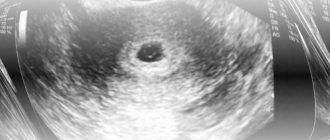Cytomorphological examination of smears
A smear is taken from the external vaginal part of the uterine cervix and from the cervical canal with a special spatula or brush. The material is then transferred to a special glass slide and sent to the laboratory for examination. The results are divided into 5 types of smears:
- The cytogram is without features. This type determines the normal level of cells and bacteria in the cervix.
- There is a slight inflammatory process, which indicates mild dysplasia. After receiving such an analysis, anti-inflammatory treatment is carried out and a repeat analysis is prescribed.
- The cellular composition indicates the presence of moderate or severe dysplasia. This type involves a high risk of dysplasia, so additional studies are prescribed (colposcopy, tissue biopsy or histological examination) that will confirm or refute the results of the smear.
- Precancerous condition. This is a clear suspicion of cancer. With this result, the woman is sent to an oncologist for a re-examination and additional research.
- Cancer. The patient is transferred to an oncology clinic, where she undergoes a series of laboratory tests again, after which she is prescribed treatment.
To obtain the correct information about the results of a smear for cytology, it is necessary to rationally prepare. Preparation for a cytomorphological study does not differ from the above preparation for a flora study.
Appropriate preparation for testing and rational collection of material ensures the correct results of the smear and the establishment of a diagnosis. You should take care of women's health and undergo an examination by a gynecologist not only in the presence of unpleasant symptoms, but also for the purpose of prevention (once every six months). This will help to identify possible infection in advance and prevent serious illness.
Leukocytes in a smear in women - the norm in the table and the reasons for increased values
Within the framework of the article, we consider leukocytes in a smear, their norm in women and a table are presented.
Leukocytes (white blood cells) are a heterogeneous group of cells, united by the presence of a nucleus and the absence of color.
They react to the penetration of infectious agents, helping the human body destroy them. Taking a smear for examination is a standard procedure for every patient when visiting a gynecologist.
An increased number of leukocytes in a smear is a sign of an inflammatory process, which requires establishing the cause and selecting adequate treatment methods. Timely detection of the disease greatly facilitates therapy and improves the prognosis.
What are leukocytes in a smear in women?
The heterogeneous population of white blood cells consists of 5 cell types that differ in morphology and functionality: neutrophils, basophils, monocytes, eosinophils and basophils.
It should be noted that during the study of biomaterial from the vagina, cervix and urethra, the total number of white cells is determined, and not each type separately.
Their main functionality comes down to protection from infectious agents and is implemented in 2 ways:
- phagocytosis – direct interaction and destruction of foreign microorganisms. At the first stage, neutrophils migrate, and then other types of cells migrate to the site of inflammation. After which they attack foreign bodies by absorbing and digesting them, followed by the release of degradation products into the environment. After the process of phagocytosis, the white cells die off, and the accumulation of dead cells forms purulent discharge. The size of objects available for phagocytosis varies from insignificantly small to large accumulations of cells;
- stimulation of the human immune system involves activating the production of antibodies that stop the proliferation of pathogenic microorganisms and also neutralize their toxins.
A lot of leukocytes in a woman’s smear are recorded when the body is infected. The disadvantage of the method is the impossibility of accurately determining which type of leukocytes is elevated. For this purpose, a general blood test is performed with a decoding of the leukocyte formula.
About the diagnostic method
The collection of biomaterial for research is carried out by a doctor in a special gynecological chair using sterile instruments. After inserting the gynecological speculum, biomaterial is taken from the posterior wall of the vagina (V) for examination using a cytobrush, from the surface of the cervix (C) with an Eyre spatula, and from the urethra (U) with a Volkmann spoon.
The level of leukocytes is determined by microscopy. In the laboratory, a Gram-stained and fixed (killed cells) smear is examined under a microscope to count the number of opportunistic bacteria and white blood cells. In addition, the presence of atypical cells characteristic of cancer pathology is visually determined.
The turnaround time for the analysis depends on the workload of the laboratory, but on average does not exceed 1 day, excluding the day of collection of the biomaterial.
How to prepare?
Preparation for taking biomaterial for research includes the following rules:
- restriction of sexual life for 2-3 days;
- for 2 days, the use of vaginal medications, as well as douching, is excluded;
- 2-3 hours of abstaining from urination;
- At least 2 days must pass from the end of menstruation. The preferred time for research is before the start of menstruation;
- Hygiene procedures are carried out in the evening and exclude the use of soap and gel.
Important: the accuracy and reliability of the results obtained depends on the correct preparation of the patient.
Leukocytes in a smear - the norm in women in the table
The decoding of the received data should be carried out exclusively by a doctor. Self-diagnosis leads to a delay in adequate treatment, which can significantly worsen the patient’s condition and the severity of the disease, including death.
Normal (reference) values of leukocytes in the vagina and cervical canal are presented in the table.
| Criterion | Normal values | ||
| Vagina (V) | Cervix (C) | Urethra (U) | |
| Leukocytes | 0 — 10 | 0 — 30 | 0 — 5 |
| Flat epithelium | 5 — 10 | ||
| Slime | Slightly | Little or no | |
| Lactic acid bacteria (Lactobacillus ssp.) | Significant amount | None | |
| Yeast (Candida) | Single cells or absent | ||
| Pathogenic flora: Trichomonas vaginalis Neisseria gonorrhoeae Escherichia coli | None |
Are additional tests and treatment needed?
Elevated leukocytes in a smear during pregnancy become a prerequisite for prescribing additional examinations that will help the doctor determine the true cause of the increase in their levels. For example, one of the common methods is called culture or PCR diagnostics. The latter helps to eliminate existing infections, and the result is very accurate. To do this, biomaterial taken from a pregnant woman is placed in a special container and examined. If the genetic material of microbes is present, they speak of the development of an infection.
Many pregnant women believe that elevated white blood cells in a smear during pregnancy do not pose any threat to the development of the baby, which means that treatment is not required. It often happens that when the tests are repeated, the number of leukocytes is established within the normal range, which indicates that the rules of personal hygiene were not observed before visiting the doctor. However, if the number of leukocytes does not decrease, it is necessary to eliminate the cause of their appearance, otherwise there is a risk of complications affecting the development and even the life of the child.
To prescribe correct and competent treatment, the doctor evaluates the condition and individual characteristics of each woman, the duration of pregnancy and the sensitivity of the microbes that caused the disease to medications. Since leukocytes in a smear during pregnancy can increase due to various diseases, the prescribed drugs may also be different. If it is thrush, then pimafucin or nystatin are prescribed, which are safe for the unborn baby. It is best to use ointments, suppositories or creams. In case of exacerbation of the disease, preference is given to tablets.
If ureaplasma is detected, the doctor decides on the prescription of treatment, based on the characteristics of the pregnant woman’s body and the course of the disease itself. Gonorrhea requires the use of antibacterial drugs such as cefixime, erythromycin and others. They are effective and do not have a negative effect on the fetus. If syphilis is detected, a product containing penicillin is needed. However, sometimes it causes allergies, so ampicillin or ceftriaxone may be prescribed additionally. During pregnancy, treatment of such a complex disease is usually carried out in 2 stages: first the treatment itself, then repetition for prevention.
Sometimes there are cases when, even after completing the entire course of treatment and repeating it for prevention, leukocytes in a smear during pregnancy are still elevated. This may indicate dysbacteriosis of the vagina itself, which requires treatment with antibacterial suppositories, and this should be repeated several times during the period of bearing a child. It is worth remembering that you cannot refuse additional examinations and the medications themselves: even if the disease is asymptomatic, it can cause infection of the uterine cavity and termination of pregnancy.
Any woman who is expecting a child regularly visits the doctor and undergoes examinations: a smear test for the presence of pathogenic microorganisms. This study is mandatory, since elevated leukocytes in a smear during pregnancy complicate its course and sometimes contribute to premature termination.
Treatment depending on the cause
Inflammation of the genitourinary tract is a threat to pregnancy and fetal health, so you should not self-medicate or abuse traditional medicine.
Therapy during pregnancy has its own characteristics, since the list of approved drugs and procedures is strictly limited. The principles of treatment directly depend on the causes of the increase in leukocytes.
Urogenital infection
Therapy is carried out depending on the type of infection detected and the extent of its spread. In the early stages of pregnancy, local medications are preferred. A woman is prescribed vaginal suppositories or tampons with medication. However, when more than 40-50 leukocytes appear in the smear, antibiotics are used, regardless of the period of pregnancy.
In the first trimester, it is possible to use penicillin-based medications (Flemoxin, Amoxicillin). From the second trimester of pregnancy, Erythromycin or Azithromycin is prescribed.
Vaginal candidiasis
Candidiasis or thrush is the most common pathology during pregnancy. The disease is eliminated with the help of vaginal suppositories, creams and tablets. The products reduce the viability of fungi and relieve itching.
In the first trimester, it is recommended to use Pimafucin and Polygynax suppositories and ointments (see also: instructions for using Pimafucin suppositories during pregnancy). In the later stages, the use of oral tablets Pimafucin, vaginal tablets Clotrimazole and Terzhinan is allowed (we recommend reading: the use of Clotrimazole tablets during pregnancy). The duration of treatment is from 10 to 14 days. However, if necessary, the therapeutic course is extended to 20 days. It is also recommended to exclude sweets and foods containing yeast from the diet during treatment.
Trichomoniasis, ureaplasmosis, mycoplasmosis, chlamydia
During pregnancy, infections can lead to miscarriage or premature birth. As a rule, infectious agents do not penetrate the placenta to the fetus, but cause pathologies in the newborn when infected through the birth canal.
The treatment regimen depends on the degree of damage to the pregnant woman’s body and the type of infection. For example, mycoplasmosis does not require urgent treatment if less than 100 units of the pathogen are detected in tests. Treatment involves taking antibiotics, so it starts in the second trimester. Medicines are selected individually. The principles of therapy are described in the table.
| Disease | Start of treatment, week of pregnancy | Drugs used | Duration of therapy |
| Chlamydia | 16 | Sumamed, Amoxiclav, Ceftriaxone | 2 – 3 courses for 10 – 14 days |
| Ureaplasmosis (more details in the article: ureaplasmosis in pregnant women) | 22 | Erythromycin | 10 days |
| Mycoplasmosis | 12 | Azithromycin, Rovamycin | 7 – 10 days |
| Trichomoniasis | 13 | Metronidazole, Atrican | 10 – 21 days |
Disturbance of vaginal microflora
Violation of the vaginal microflora most often becomes a consequence of pathological processes occurring in the body, so restoration of the flora takes place in several stages:
- elimination of primary pathology;
- enrichment of microflora with beneficial bacteria;
- increasing general immunity.
To reduce colonies of pathogenic microflora, local antiseptics are used, for example Miramistin. After eliminating the cause of the imbalance of vaginal flora, women are prescribed vaginal suppositories and tampons with lacto- and bifidobacteria (Lactobacterin, Acylact). To improve immunity, it is recommended to take vitamins and adhere to proper nutrition. Therapy lasts from 14 to 30 days.
Gonorrhea and herpes
Gonorrhea and herpes during pregnancy are treated if a high risk of infection of the fetus and the development of complications in the expectant mother is identified. Gonorrhea is treated in the 2nd and 3rd trimesters with antibiotics. As a rule, a short course of therapy with Erythromycin, Azithromycin or Ceftriaxone is prescribed.
For herpes, local remedies in the form of ointments are recommended. Pregnant women can use Zovirax. In severe cases of the disease, antiviral drugs containing interferon are used.
General information
The vagina is an organ that communicates with the environment. Therefore, it must have effective mechanisms to protect the mucous membrane from foreign agents. One of them is represented by vaginal microflora. Its representatives prevent the development of pathogenic microbes due to competitive antagonism, maintaining an acidic environment (pH), and the synthesis of enzymes, vitamins and other biological substances. The normal state of the natural biocenosis contributes to the production of secretory immunoglobulins and the maintenance of cellular immunity reactions and the neutralization of toxic metabolites.
The vaginal microflora consists of 95% lacto- and bifidobacteria, i.e. rod flora. And the remaining amount is opportunistic organisms. These include enterococci, gardnerella, candida, bacteroides, staphylo- and streptococci, fusobacteria, etc. Under normal conditions, they are in a state of symbiosis, without causing any harm. But when creating a favorable environment, such microbes are able to significantly expand their sphere of influence, displacing other representatives of the vaginal biocenosis.
Why determine the level of leukocytes in a smear during pregnancy?
The content of white blood cells in the smear must be monitored in order to promptly detect the development of fungal, bacterial, or viral infections in the body. As well as inflamed foci in places where pathogens grow and reproduce. The earlier the disease is diagnosed, the easier it is to treat
During pregnancy, the health of the genitourinary organs is especially important, since any inflammation in them leads to complications during pregnancy. From the vagina, pathogens can spread into the uterine cavity and penetrate into the amniotic fluid, causing infection of the embryo and even spontaneous abortion.
In places where pathogenic microscopic flora develops, the number of white blood cells increases significantly. Therefore, their concentration in the smear biomaterial can be considered an indicator that determines the presence or absence of foci of infection and reproduction of pathogenic, disease-causing particles in the genital, reproductive, and reproductive organs (and not only, since some infections penetrate the systemic bloodstream and affect the entire body). If the content of leukocytes in a smear (blood, urine) significantly exceeds the standard value, doctors diagnose leukocytosis.
They provoke inflammatory processes in the female genital and other organs:
- fungi of the genus Candida - they cause the development of candidiasis or thrush;
- actinomycetes - actinomycosis, and gardnerella - gardnerellosis;
- Trichomonas - trichomoniasis, and chlamydia - chlamydia;
- mycoplasmas - mycoplasmosis, and gram-negative microbes of ureaplasma - ureaplasmosis;
- gonococci - purulent inflammation of the urinary tract gonorrhea, and Koch's bacilli - tuberculosis;
- amoebas - amoebiasis, intestinal dysentery, and gram-negative pleomorphic bacilli Klebsiella granulomatis (Donovan bodies) - inguinal granulomas or donovanosis;
- treponema pallidum, which causes the chronic systemic venereal disease syphilis, and cytomegalovirus, a type of herpes;
- HPV, HIV (viruses that cause genital cancer and the development of immunodeficiency syndrome), etc.
Additional examinations help identify pathogens and diagnose infectious diseases. They are prescribed by a doctor based on the results of laboratory tests of the vaginal microflora:
- bacteriological culture - identifies harmful bacteria that, when multiplying, can cause inflammatory processes;
- PCR - polymerase chain reaction - allows you to detect any DNA and RNA in the test material, it is considered the most accurate method for detecting hidden viral and any other infection;
- immunological studies - determines the amount of immune cells and antibodies in the blood, making it possible to assess how much the immune system is involved and tense at the time of taking the test.
While carrying a child, a woman’s immunity may decrease due to changes in body systems and instability of hormone levels in the blood. As a result, sluggish and chronic inflammations worsen, the growth of pathogens and microorganisms of transistor microflora is activated. Infection can also occur directly during pregnancy. Therefore, monitoring of leukocytes in the smear and the state of the vaginal microflora is carried out several times from the moment the expectant mother is registered with the antenatal clinic (LC) until delivery.
The concentration of leukocytes in a smear is determined by the number of white blood cells in the field of view on the glass under a microscope
The role of cells in the body
The process of destruction of foreign and dangerous elements by leukocytes is called phagocytosis. They capture and absorb “enemies”, then die themselves.
What are leukocytes in a smear in women?
Their main functions:
- Production of antibodies to fight external and internal “enemies”.
- Normalization of metabolic processes and supply of tissues with necessary enzymes and substances.
- Cleansing the body - eliminating pathogens and dead leukocytes.
Normal, why indicators may be increased
An increase in leukocytes in a smear in women is a sign of an inflammatory process in the body .
You can find out their level by taking tests:
- flora smear;
- blood analysis;
- Analysis of urine.
- Women are most often prescribed a smear test for flora.
- This study allows you to identify diseases of the urinary canal, kidneys or bladder; recognize the inflammatory process in the urogenital area.
- Material for research is taken:
- from the vaginal wall;
- from the mucous surface of the cervix;
- from the mucous membrane of the urethra.
Normal levels of immune cells in a smear:
- from the vagina - no more than 10;
- from the urethra - no more than 5;
- from the uterine cervix - no more than 15.
Table of the norm of leukocytes in a smear in women and other analysis indicators:
During the study, it is necessary to take into account the following features:
- The number of white blood cells (leukocytes) increases after sexual intercourse; elevated levels last for 24 hours after the act.
- Increased levels are observed during the installation of an intrauterine contraceptive device.
- Microtraumas of the vaginal walls also increase the indicators.
The main reasons for an increase in the number of leukocytes in a smear in women are:
- Sexual infections transmitted directly during sexual intercourse (STIs):
- Gonorrhea.
- Chlamydia.
- Ureaplasma.
- Syphilis.
- Trichomoniasis.
- Mycoplasma.
- Papillomaviruses.
- HIV.
- Candidiasis.
- Cytomegalovirus.
- Actinomycetes.
- Genital herpes.
- Bacterial vaginosis. This disease is better known as vaginal dysbiosis. Occurs when the number of pathogenic microorganisms in the vaginal flora increases.
Prerequisites for the development of the disease are hormonal disorders, decreased local immunity, or the use of vaginal suppositories.
- Allergic reaction to gels and lubricants for intimate hygiene or douching products.
- Oncological diseases of the reproductive system.
An increased content of white immune cells in a smear indicates the presence of the following diseases:
- Colpitis is an inflammatory process of the vaginal mucous tissues.
- Cervicitis is an inflammatory process of the cervical canal.
- Endometritis is an inflammatory process of the mucous surface of the uterus.
- Adnexitis is an inflammatory process of the ovaries and fallopian tubes.
- Urethritis is an inflammatory process of the urethra.
- Dysbacteriosis of the intestines or vagina.
- Oncology of the reproductive system.
Symptoms of increase
Signs indicating an increase in the level of leukocytes and the development of an inflammatory process in the urinary system:
- painful urination;
- the appearance of a false urge to urinate;
- discharge of an unusual nature;
- pungent odor of genital discharge;
- burning and itching sensation inside the genitals;
- failure of the menstrual cycle;
- problems with conception;
- discomfort during sexual intercourse.
The inflammatory process can occur without pronounced symptoms. It is important to listen to the slightest deviations.
A large number in pregnant women
During pregnancy, a smear test for flora is required, both during registration and before birth.
Indicators are within the acceptable norm - 10-20 units in the observation field. And an increased amount indicates the development of inflammation.
Often during pregnancy, many diseases that did not manifest their presence before conception become aggravated.
There is a change in hormonal levels , immune defense decreases, and often pregnant women develop thrush or candidiasis. If an elevated level of white blood cells is detected, it is necessary to undergo an examination to determine the exact cause of the inflammatory or infectious process.
The causes of elevated white blood cells in a smear in women may include:
- Sexually transmitted diseases (ureaplasmosis, syphilis, gonorrhea and others).
- Thrush.
- Vaginosis.
- Colpitis.
Doctors often prescribe the drug to strengthen local immunity:
- Echinacea.
- Immunal.
- Eleutherococcus.
- Ginseng.
For the treatment of vaginosis the following is prescribed:
- Bifidumbacterin.
- Lactovit.
- Lactofiltrum.
High content after childbirth
Leukocytes instantly react to the slightest deviations or changes in the functioning of the body. Therefore, their levels often increase for physiological reasons. This also includes the postpartum period.
- During childbirth, a woman loses a lot of blood.
- To prevent complications, immune white cells are prepared in advance for such a situation and accumulate in large numbers in the uterine area.
- This is associated with an increase in the number of their indicators in a smear after childbirth.
Their number increases during the onset of labor and during the recovery period. The indicators return to normal 4-5 days after birth.
In such cases, you should immediately consult a doctor.
Possible danger of exceeding
Chronic and frequent increase in the level of white blood cells in the body can lead to serious complications.
Possible risks:
- The onset of infertility.
- Ectopic pregnancy.
- The appearance of erosion.
- Manifestation of mastopathy.
- Abnormalities in the functioning of the bladder or kidneys.
- Ovarian dysfunction.
- Formation of adhesions and fibroids.
Diagnostics and medical assistance
If an increased level of leukocytes is detected in the smear, you should consult a doctor:
- Gynecologist.
- Dermatovenerologist.
- Infectious disease specialist.
The following types of diagnostic procedures are most often prescribed:
- sowing on flora;
- flora smear;
- ELISA (enzyme-linked immunosorbent assay);
- test for antibodies in the blood;
- biopsy;
- PCR (polymerase chain reaction);
- CBC (complete blood count);
- OAM (general urinalysis);
- Ultrasound of the abdominal cavity.
Drug treatment
As noted, an increase in white immune cells can occur due to an inflammatory or infectious disease. Treatment for inflammation or infection is varied.
Treatment of the inflammatory process is carried out according to the following scheme:
- Use of antiseptics. The vagina is regularly washed with antiseptics “Miramistin”, “Chlorhexidine”, “Potassium permanganate”.
- Antibacterial drugs are used. "Genferon", "Pimafucin", "Terzhinan", "Viferon" are prescribed.
- For the treatment of candidiasis - Fluconazole and Flucostat.
Treatment of the infectious process is carried out according to the following scheme:
- Intravenous use of antibacterial agents: Ornidazole, Metronidazole and Tsiprinol.
- Prescription of drugs for the prevention of vaginal dysbiosis: “Bifidumbacterin”, “Laktovit” and “Lactofiltrum”.
How to treat with traditional methods
Traditional methods involve the use of homemade herbal decoctions for douching and oral administration.
They can be prepared according to the following recipes:
- Pour one dessert spoon of dry chamomile herb (can be replaced with nettle, calendula, St. John's wort) into glasses of boiled water. Bring to a boil over low heat, remove from heat, leave for half an hour. Strain. Use for vaginal douching.
- You can douche with soda. To prepare the solution, use half a small spoon of baking soda. It is diluted with a glass of warm water.
- A decoction of St. John's wort for oral administration is useful. One dessert spoon of herb is poured into a glass of water and boiled for a quarter of an hour. Strain, take 1/4 cup three times a day.
- You can prepare a medicinal bath from a decoction of dry laurel leaves. 20 g of herb is diluted in a full bucket of water. A sitz bath is taken in this decoction.
Frequency of swab collection
According to the order of the Ministry of Health of the Russian Federation dated January 17, 2014, smears for the microflora of the urogenital tract are taken three times:
- the first time when a woman registers (usually in the 1st trimester);
- the second time before going on maternity leave (at 30 weeks);
- for the third time before childbirth, at the end of the 3rd trimester (at 36 weeks).
Additional smears are taken according to indications:
- pregnant woman's complaints of leucorrhoea, itching and burning;
- control of the treatment of vulvovaginitis confirmed by laboratory tests;
- threat of miscarriage or premature birth;
- polyhydramnios and oligohydramnios;
- history of miscarriage and frozen pregnancy;
- isthmic-cervical insufficiency;
- intrauterine fetal infection;
- Chorioamnionitis.
In some cases, PCR diagnostics using a smear is prescribed to detect sexually transmitted infections (chlamydia, ureaplasmosis, cytomegalovirus and others).
Causes of increased leukocytes in pregnant women
There are many factors that caused an increase in the number of these cells. As a rule, these are processes characterized by inflammation of various parts of the female genitourinary system:
- urinary canal;
- internal vaginal mucosa;
- ovaries;
- cervical canal;
- inner layer of the uterus.
Oncological diseases of the genitourinary system and intestinal dysbiosis can also cause an increase in the number of white blood cells in a smear.
In addition to these diseases, more serious diagnoses may also cause an increase in protective cells in the body. In particular, these are sexually transmitted infections - from genital herpes to gonorrhea and syphilis. In total, there are more than 20 such diseases on doctors’ lists. They are dangerous for people of any age and position, and during pregnancy, when the mother’s immunity is weakened and the child’s immunity has not yet been formed, they pose a particular threat.
However, it often happens that in pregnant women, an increase in leukocytes is provoked by thrush, which is familiar to many women - damage to the vaginal mucosa by the candida fungus. In this case, a woman may experience symptoms such as burning or itching in the vagina, or a cheesy discharge. Often, thrush accompanies a pregnant woman throughout her entire pregnancy, and after the next course of treatment it appears again. But this is not a reason to stop treatment and let the disease take its course: the consequences of thrush can be very serious, and during childbirth, the child can become infected with a fungus.
There are some cases where an increased level of white blood cells in a smear does not indicate infection or inflammation. Most often this is associated with unprotected sexual intercourse when the partner has any prostate disease. In this case, a repeat test should show a normal level of white cells.
Bad smear during pregnancy
Key (atypical) cells, trichomonas, gonococci and yeast-like fungi are found in certain diseases. In case of a bad smear during pregnancy, the gynecologist prescribes an additional examination for the purpose of accurate diagnosis. Infection testing is also carried out to detect sexually transmitted diseases. After the diagnosis is established, the doctor prescribes a course of treatment. 4.8 out of 5 (23 votes)
At an appointment with a gynecologist, a pregnant woman undergoes many different diagnostic procedures. A smear on the flora is one of the most important studies during this period. This analysis is necessary to determine the presence of pathogenic microflora, atypical cells and assesses hormonal balance.
The analysis is usually carried out under the following circumstances:
When registering. At 30 weeks. Before childbirth. If there are complaints. With polyhydramnios, threat of miscarriage, infection of the fetus.
Preparing for a smear on the flora.
If a pregnant woman knows that a sample of the microflora of the genital tract will be taken, she should know the following before the study:
1. Before taking the test, you must avoid sexual intercourse, douching and suppositories. 2. Before the test, you should not take various antibacterial drugs or notify your doctor about taking them. It is recommended to do a smear a week after the end of therapy. 3. You can’t wash yourself diligently before a smear. 4. It is advisable not to go to the toilet two hours before your appointment.
The procedure for taking a smear during pregnancy.
This procedure is performed on a gynecological chair. The mucous membranes are collected using a sterile or disposable instrument. The sites for collection are the urethra, the lateral wall of the vagina and the cervix. The laboratory assesses the amount, color and odor of the discharge.
The degree of purity of the smear is also distinguished:
The first degree of purity has an increased number of Dederlein bacilli, an acidic environment and a small content of opportunistic flora. There are isolated cases of red blood cells and white blood cells.
Second degree. The nature of the environment is acidic, low levels of lactobacilli, pathogenic microorganisms have been identified. Leukocytes can reach 15 units per field of view.
Third degree. At the third degree of purity, the environment becomes alkaline, leukocytes reach more than 20 units in the field of view. Lactobacilli are practically absent. The smear contains streptococci and staphylococci in large quantities.
Fourth degree. Alkaline environment, complete absence of lactobacilli, a huge number of leukocytes. Pathogenic microorganisms appear, and red blood cells may be present. All these are signs of an inflammatory process.
Norms of smear on flora during pregnancy.
Indicators may differ depending on which area of the genital tract the smear is taken.
1. Norms for indicators of a smear from the vaginal mucosa:
Leukocytes from 0 to 15 units. The microflora has a high content of lactobacilli. Gonococci – absent. Trichomonas – absent. Yeast in small quantities.
2. Norms of cervical smear indicators:
Flat epithelium from 5 to 10 units. Leukocytes from 0 to 30 units. Microflora is not determined. Mucus in moderation. Gonococci – absent. Trichomonas – absent. Yeast - absent.
3. Standards for urethral smear:
Flat epithelium from 5 to 10 units. Leukocytes from 0 to 5 units. Microflora is not determined. Mucus - absent. Gonococci – absent. Trichomonas – absent. Yeast - absent.
Deviations from the norm.
The absence of squamous epithelium may indicate low estrogen saturation of the body, and a large number of them may indicate an inflammatory process.
An increase in white blood cells above normal and abundant mucus almost always indicate inflammation.
Any deviations from the norm are always accompanied by additional studies, and when the diagnosis is confirmed and made, appropriate treatment is prescribed.
The material was prepared specifically for the site
Tests: when and how to take them
In the absence of complications during pregnancy and the woman’s complaints about vaginal discharge, discomfort or pain in the lower abdomen, the expectant mother takes a urogenital smear for flora (including leukocyte content) 2 or 3 times:
- from 4 to 10 weeks of pregnancy - after registration in the housing complex;
- at 29 or 30 weeks - when it’s time to take maternity leave;
- at 36 weeks - before delivery.
If during the next scheduled preventive examination of a pregnant woman, the gynecologist discovers any symptoms, complications, deviations from the norm, or the woman has certain complaints, additional examinations will be prescribed.
Some preparation is required before taking a smear to obtain the most accurate test results.
- Be sure to abstain from sexual intercourse for two days before visiting the residential complex.
- You cannot douche for 48 hours before taking the test.
- One day before, stop using any vaginal medications: suppositories, ointments, creams, tablets.
- You can wash yourself the day before your appointment with a doctor - with warm water, without using soap or other intimate hygiene products.
- Your last urination should take place at least 2–2.5 hours before donating biomaterial from the genital organs.
If there is bloody discharge, urogenital smears are not suitable - they can significantly distort the results. If you don’t wash yourself well or have sex before the test, much more white blood cells may be found in the smear, and such a study cannot be considered reliable.
The procedure for taking a urogenital smear includes taking biomaterial not only from the vagina, but also from the cervix and urethra (V, C, U). And the indicators of each sample will be slightly different, which is normal and physiologically justified. The doctor should use only sterile (preferably disposable) instruments - a Volkmann spoon, an Eyre spatula, a gauze swab, and glass slides.
In the laboratory, the biomaterial dried on glass slides is stained before being studied - special dyes help ensure that white blood cells, pathogens and transistor (conditionally pathogenic) flora become clearly visible. The number of white blood cells is determined by the concentration of these immune blood particles in the field of view under a microscope.
Special dyes are used to identify different types of microorganisms in a smear.
Decoding the results
For correct interpretation of the analysis, consultation with a doctor is necessary. He will evaluate not only the presence and quantity of what is detected, but also the ratio. As for leukocytes, they are detected under a microscope. This allows you to count the number and determine the degree of maturity of cells by their appearance. The smear is stained with special dyes to see these colorless bodies.
Leukocyte norm table
The largest number of leukocytes is found in the cervical canal (in the cervix). There, their healthy number can reach several dozen. This is due to the fact that the uterine cavity is lined with such a covering, which, firstly, is of key importance in fertilization and development of the embryo, and secondly, infection develops there more easily and quickly. Therefore, a larger number of cells will guard the entrance there.
Fewer white blood cells are found in the vagina. The structure of the epithelium of this organ provides it with more pronounced protection. The smallest number of immune system cells is found in the urethra. Urine constantly circulates there, which in itself protects the cover and simply physically “washes away” everything unnecessary. Also, this environment will be quite aggressive for leukocytes. Therefore, the rules are different here. The number of cells is shown in the table below.
Increased levels of white blood cells
For the convenience of assessing and classifying the degree of damage to the genital tract, a division of the vagina according to degrees of cleanliness was developed. They mean the “saturation” of the reproductive system with microorganisms and its response to this.
Normally, there is a balance between good and bad microbes, which is maintained by all normal elements of the vagina.
Based on their ratio, 4 degrees of purity are distinguished.
First
This degree occurs in absolutely healthy women and is rarely detected in real practice for various reasons. In this case, the predominant flora will be Dederlein's bacilli; single leukocytes, always mature, are secreted into the vagina. The reaction of the environment is acidic, and pathogenic microbes are absent.
Second
The second also reflects the norm, but is already found in most healthy women. Dederlein's rods will also be the overwhelming species of microorganisms, there is some epithelium and mucus. Leukocytes can already reach up to 10 cells in the vagina, 15 in the cervical canal and a few in the urethra. A small number of round cocci bacteria, harmless to the body, appear. But dangerous microbes are not released.
Third
Gynecologists often call this degree vaginal dysbiosis. This means that the normal ratios of all elements, as well as microbes, begin to be disrupted. This indicates the beginning of the inflammatory process. Therefore, the number of leukocytes increases. Up to 30-50 cells are already found in the vagina, the number is growing in the cervical canal and the external opening of the urethra. But the leukocytes will be mature, and the number will not exceed more than 5-7 times.
Characterized by a decrease in lactic acid bacilli and an increase in opportunistic flora. The amount of epithelium and mucus naturally increases. And the reaction from acidic becomes slightly acidic or alkaline. Trichomonas, gonococci and other similar bacteria have not yet been detected.
Fourth
The fourth degree is called vaginosis. In this case, there is a pronounced infectious process in the reproductive system with all its characteristic features. Leukocyte levels increase several times, and juvenile forms may be detected. If the inflammation reaches this level, then pus with a sharp, unpleasant odor is released from the vagina. Pathogenic bacteria appear and actively multiply: gonococci, chlamydia.
Beneficial rods are not released at all, and the environment becomes alkaline. The amount of epithelium also increases, taking part in creating a breeding ground for microbes. Leukocytes can no longer cope with either protective or sanitary functions.
The third and fourth degrees require medical intervention and medication. But the first and second are a variant of the norm. It should also be remembered that one or another diagnosis cannot be made based on just an increase in the number of leukocytes in a smear, because errors in collecting the analysis or in preparation can artificially increase the number of colorless cells in the smear.
This can be facilitated by:
- contamination of instruments;
- sexual intercourse on the eve of the study;
- aggressive personal hygiene the day before;
- frequent use of personal hygiene products;
- incorrectly chosen time for analysis (closer to the end of the cycle and immediately before menstruation).










